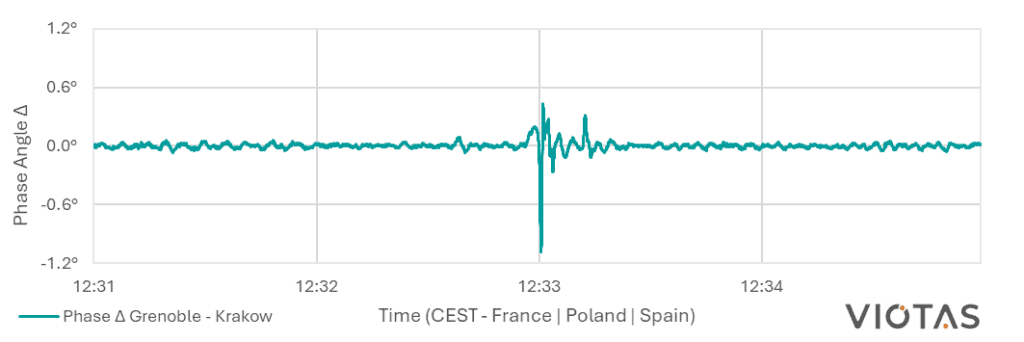
VIOTAS Commentary on the Iberian Blackout
Twelve thirty-three and twenty seconds – the moment panic dissolved into jaw-dropping disbelief. Within five seconds, operators at the Centro de Control Eléctrico in Madrid, had felt the rope slip through their hands as they were plunged into every grid operator’s worst fear: “0 Hz” — a blackout.
They weren’t alone. At the Centro Nacional de Despacho just outside Lisbon, operators at Portugal’s Rede Eléctrica Nacional were staring at the same vanishing frequency, caught in the same cascading failure. And further north, engineers at France’s Réseau de Transport d’Électricité looked on as the Iberian Peninsula became an island, electrically separated from the Continental European Grid (CESA) — C’était quoi ce bordel?
As two economies ground to a halt, key infrastructure switched to batteries and backup generators with no certainty of how long they could hold. Word spread from Portugal that the event had been triggered by a “rare atmospheric phenomenon”, easing initial fears of a cyberattack or terrorism. But this theory was swiftly dismissed by Spanish meteorologists. Since then, Red Eléctrica de España has indicated that the most likely trigger was the near-simultaneous disconnection of two solar farms in southwestern Spain.
And yet, while investigations into the root cause of the Iberian Peninsula blackout continued, one thing soon became clear: it was not the trigger itself, but the five seconds that followed — five seconds of events that culminated in the catastrophic failure of two national power systems — that will force grid operators around the world to sit up, take notice, and reappraise how robust their mitigation measures are.
So, what appears to have happened?
First, three important fundamentals of grid stability relating to this event
Those already familiar with power systems may want to skip ahead.
Power System Inertia
In a grid powered entirely by traditional generators, like nuclear, gas, and hydro, these generators sum to several thousand tonnes of metal, spinning at 3,000 rpm, acting together like a giant flywheel to provide inertia. Like a moving supertanker, this rotating mass helps to stabilise the grid by resisting sudden changes in its speed, meaning small disturbances will have little impact on the frequency and larger disturbances are slowed, buying grid operators valuable seconds to correct imbalances.
In contrast, a power system powered solely by wind and solar via traditional inverters has no spinning mass connected to the grid – the inverters electrically separate the wind turbines and solar panels from the grid itself. Without inertia, even small mismatches between supply and demand cause frequency to swing instantly. If not corrected immediately, this can breach safety thresholds and force generators offline — triggering a blackout. The key difference is reaction time.
- A grid with high inertia has the stopping distance of a supertanker — slow to drift, slow to fail.
- A grid with no inertia reacts like a pedalo — every nudge counts, and there’s little time to recover.
Grid operators aim to run the power system at a point on this spectrum that maximises renewable energy while still preserving enough inertia — or fast-acting substitutes — to give automatic controls time to respond to sudden imbalances.
Contingency Reserve
Because failures can and do happen, grid operators keep reserve capacity, contingency reserve, on standby — power that can be called on quickly if a generator or transmission line unexpectedly drops offline.
The size of this reserve is typically based on the largest single infeed — in other words, grid operators have traditionally assumed that the worst-case failure is the loss of the biggest generator or interconnector on the system. The logic is simple: if that fails, the grid should have enough reserve to cover the loss immediately.
In systems with high renewables and low inertia, the reserve doesn’t just need to be large enough — it also needs to be fast enough. Technologies like battery storage and fast demand response are becoming more important because they can react in fractions of a second, far quicker than traditional power plants.
Sympathetic Tripping
When a generator or interconnector trips, it creates a disturbance that ripples across the grid. When renewables are low and inertia is high, such disturbances are usually absorbed quickly and don’t propagate very far. But when renewables are high and inertia of low, these disturbances can spread rapidly — and cause other generators or interconnectors to trip, particularly those in close proximity, in a behaviour called sympathetic tripping.
Sympathetic tripping has become more common as grids operate at higher levels of renewables and lower inertia and can, in severe cases, lead to a cascade of failures. Yet most grids still plan their contingency reserve requirements based on the assumption that only one asset will fail at a time — an assumption that no longer holds true.
What appears to have happened
When a major grid event occurs, the natural impulse is to seek comfort by drawing a line between “us” and “them” — to search for the reason why it couldn’t happen here. But from what we know so far about this case, that comfort is hard to find. For many grid operators around the world, the uncomfortable truth is that the conditions in Spain on April 28 were not unusual. In fact, they were increasingly normal.
Spain, the first domino to fall, appeared to be in excellent shape in the minutes leading up to the event. Nearly 70% of its electricity was being produced by wind and solar, with an additional 10% from hydro. It was not only meeting its own demand but exporting around 11% of its generation to neighbours: supplying approximately 30% of Portugal’s electricity at the time, along with 13% of Morocco’s and nearly 2% of France’s. Remarkably, a further 11% of Spain’s generation was being directed into pumped hydro storage, reflecting just how abundant and unconstrained its renewable energy supply was at that moment.
With 2,800 MW of AC interconnection to France, Spain was not operating in isolation. It had the inertial backing of the entire Continental European Grid — a massive kinetic safety net that, in theory, should have allowed it to ride through the loss of even any one of its largest single generating units. These units, typically its nuclear-powered units, range from 1,000 to 1,100 MW. The system, according to the conventional wisdom, should have coped.
And yet, it didn’t.
But Spain did not just lose one – it lost multiple. Having not been immediately counteracted, the initial near-simultaneous tripping of two large solar farms in the southwest of the country, while wind and solar were high and inertia was low, likely triggered sympathetic tripping by other nearby generators. This will have escalated the disturbance, increasing the likelihood that others would follow, and so it seems they did – creating an avalanche effect that propagated across the grid. An inability to counteract the initial trip while the scale of the issue was manageable, allowed a sequence of events to unfold that, in just five seconds, resulted in the loss of 15 GW of power. This was fifteen times the capacity of the largest single unit that contingency reserves are typically designed to handle – and was over in a third of the time that Spain allows for its fastest contingency reserves to respond – 15 seconds. The scheduled contingency reserve would have been too little, too late.
From that point the grid will have entered freefall, with generators and interconnectors being forced to disconnect to protect themselves, accelerating the collapse. Portugal, which was relying on Spain for around 30% of its electricity at the time, was exposed to the same sequence of failures. As the two countries share a tightly meshed synchronous network, the instability spread freely across both systems.
Meanwhile, Spain’s nuclear plants will have engaged critical safety systems to protect themselves and direction of flow of the AC interconnectors connecting Spain to France is likely to have reversed, with France providing a momentary lifeline of support before the interconnectors also tripped – islanding the Iberian Peninsula from the rest of the Continental European Grid.
The impact of the separation was felt across continental Europe. VIOTAS’ VIO Link systems – a smart grid system that monitors the grid up to 8,000 times per second to provide near-instant countermeasures to such disturbances in other countries – recording a separation of synchronism of more than 1° between Grenoble, France and Krakow, Poland. Due to its proximity, the impact was far more pronounced in Grenoble than Krakow. In the first chart below, we can see the frequency on the French grid drop as it swings from being a consumer to being a supportive provider to Spain, followed by a rapid increase in frequency, like a spring releasing as the interconnector disconnects and the load drops. Fortunately, this is quickly arrested, presumably due to the activation of automatic protection measures, with the frequency resynchronising to the wider grid. Thanks to the speed at which this oscillation was brought under control, France emerged largely unscathed, with the French Basque Country, in the southwest, experiencing relatively minor power outages lasting only a few minutes.

Was Renewable Energy to Blame?
Red Eléctrica de España has indicated that the incident was triggered by the near-simultaneous disconnection of two solar farms. Combined with high levels of wind and solar generation — and the resulting low inertia — this created a system unable to absorb what may otherwise have been an inconsequential disturbance. In that sense, it would be hard to argue that renewables played no role. Had there been no wind or solar on the system that day, this event likely would not have unfolded the way it did.
But that doesn’t mean renewable energy was the issue — it’s how we prepare the grid to work with it.
The value that wind and solar deliver across the Iberian Peninsula — especially when paired with hydro storage — continues to strengthen energy security, economic resilience, and independence from fossil fuel volatility. The problem isn’t the technology; it’s the lack of adaptation around it.
The focus must shift from whether we use renewables to how we integrate them. Just as the body needs vitamin C to absorb iron, a grid rich in wind and solar requires complementary support — like synchronous inertia and ultra-fast contingency reserves — to stay healthy. These are manageable challenges, not fundamental flaws.
What lessons will be learned?
While details surrounding the event are still emerging, grid operators won’t need to wait for a final report to recognise some of the key challenges at play, and will be reflecting deeply on what lessons they need to take from this.
Spain was generating almost 70% of its electricity from low-inertia wind and solar in the minutes leading up to the failure. Was this unusual? No, this would be a regular occurrence — not only in Spain but also in Germany, Great Britain, Ireland, Australia, and the U.S. markets of ERCOT (Texas), CAISO (California), and SPP. However, being common doesn’t mean they are invulnerable. Most of these grids will have had their own near-misses — not always averted by good design alone, but often helped by good fortune. Ireland’s sequential loss of two interconnectors in May 2024, which you can read about here, is one such case.
Unlike Spain, many of these markets have begun to procure high-speed contingency reserves to arrest frequency events before they escalate. This service is typically delivered by battery storage or demand response — temporarily shedding non-sensitive loads like chillers, pumps, and furnaces — to restore balance. These responses are activated within one second, and in Ireland’s case, as quickly as 0.15 seconds.
In contrast, Spain’s fastest contingency reserve requires a 15-second response. The events of April 28 suggest this was far too slow. It is highly plausible that if sub-second reserves had compensated for the initial loss of generation, the cascade of sympathetic trips may have been avoided. The introduction of fast-acting, sub-second contingency services could therefore be a crucial step in reducing this risk going forward.
At the same time, restoring inertia to the system remains critical. One promising approach in strong favour with grid operators is the use of synchronous condensers, which provide rotational mass and short-circuit strength without the need for active generation. These devices can help anchor frequency and resist sudden swings, especially when paired with inverter-based renewables. While they don’t replace the need for fast reserves, they complement them — inertia slows the collapse, fast reserves stop it.
In any case, the pace at which it appears sympathetic tripping caused the scale of the event to escalate was extreme. It clearly demonstrated that the failure of the largest unit on the grid is no longer the largest credible risk that needs to be provisioned for. It’s multiples of that – and the volumes of contingency reserve being procured by operators of grids with high levels of inverter-based renewables needs to be increased accordingly.
Final thoughts
While the full picture may shift as investigations continue, the broad contours of what happened on April 28 appear clear: a seemingly benign disconnection of solar generation triggered a cascade that overwhelmed Spain’s grid and led to the isolation and blackout of the entire Iberian Peninsula.
What will be most unsettling for other system operators is just how unremarkable the lead-up appeared. Spain’s grid wasn’t under stress. There were no storms, no cyberattacks, no equipment failures beyond the initial trip. Nothing about that day stood out as extraordinary. And that’s exactly the point.
For operators of similarly renewable-rich systems, there are few comforting distinctions to draw. Many have faced their own near-misses — crises averted not by flawless design, but by timing, luck, or surplus. Spain didn’t have that luxury. But now, the luxury of hindsight is available to everyone else.
The lesson is clear: the old standard — planning for the loss of the single largest infeed — is no longer enough. In high-renewable, low-inertia grids, the biggest threat will not be a single failure, but the domino effect that follows. Don’t plan for the largest unit to fail — plan for the first failure to cascade. And the only antidote is speed. Not ten seconds. Not five. But sub-second action, delivered through battery storage and demand response, and in volumes well beyond the traditional benchmark.
This was a test Spain didn’t see coming. For their counterparts around the world, it’s no longer possible to say, “We didn’t see it coming.”



